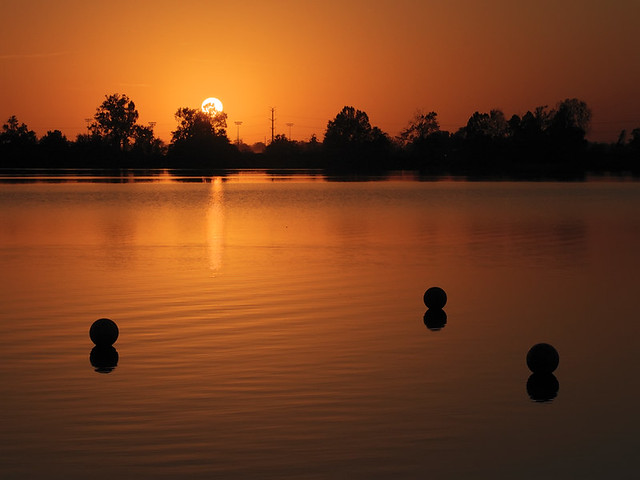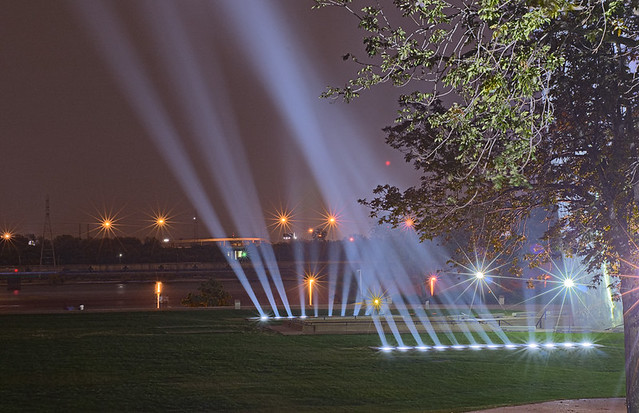THE EVE OF All Hallow's Day has become one of the major American festivals, and in a typical American fashion, has incorporated many facets of our culture, including commercialism and hedonism.
Let us not forget that the root of the world culture is the Latin cultus, or religion, and our celebration of Halloween is formed by religious and philosophical ideas: some orthodox, some heretical. The Timman quotes John Zmirak in some amusing articles on the subject.
One of the most annoying aspects of the current celebration is how a festival for children (revolving around getting free candy) has morphed into a rather more hedonistic one for adults. Of course, the immaturity of our current culture is rampant, and as no one wants to take the responsibility to be an adult, Big Government takes the role of our daddy. I remember precisely the time when Halloween became an adult festival: soon after the first reports that some evil people were putting razor blades into apples and giving them to children. I do not know the veracity of that urban legend: perhaps it was promoted by dour Puritans or Marxists who hate the idea of anyone having an innocent good time.
Equally disturbing is the loss of the significant adult part of the festival, although this aspect of Halloween likely never had a significant influence in Protestant America, where Halloween is also Reformation Day. Luther's dislike of indulgences and Henry VIII's envy of the monasteries led to the loss of one of the most important ritual aspects found in nearly all religions in the world, which is prayer for the dead. You don't have to use the word Purgatory to describe the state of poor departed imperfect souls who are unable to find rest without help. Natural religion prays for the departed, Orthodox Judaism prays for them too, and the ancient Apostolic Christianity found in the Eastern and Catholic Churches prays for the dead. Our culture does not, and this idea has even infected Catholicism itself: I've been told on several occasions — by Catholics — that I needn't bother praying for a particular departed, because they were “good”; and current celebrations of the Funeral Mass often don't help matters either.
Also, we naturally recognize that some of these souls will never find rest, and that is an important aspect of Halloween, a mockery of the souls damned in Hell, and how they got there. This part of the festival is the most problematic, as the linked articles above demonstrate. I do think that having All Saints celebrations for children is an admirable practice for Catholics, but I also think that we ought to keep the popular customs about the damned also in mind: for one is a goal, the other is a warning.
Halloween also has aspects of a harvest festival, as our traditional decorations of pumpkins, cornstalks, and hay bales demonstrate. Certainly, celebrating the change of seasons is admirable, even if pagans do it, because God made the world and it was very good.
A proper adult understanding of Halloween needs to take into account the context of All Saints and All Souls Days, as well as the change in seasons, the end of the liturgical year, and eschatological considerations of Christ's return in triumph as King, the end of the world, and the destination of our own souls. As American culture understands almost none of these, we have a lot of work ahead of us.
Saturday, October 30, 2010
Some Thoughts on All Hallow's Eve
Wednesday, October 27, 2010
"Thursday Night Pizza"
A NEW COOKBOOK, Thursday Night Pizza, by Father Dominic Garramone, O.S.B., is now available. Click below to purchase a copy:
I took the photo on the cover and of the pizzas.
Father Dominic is a Benedictine monk who lives at Saint Bede Abbey, in Peru, Illinois, and is known for his PBS television series Breaking Bread with Father Dominic.
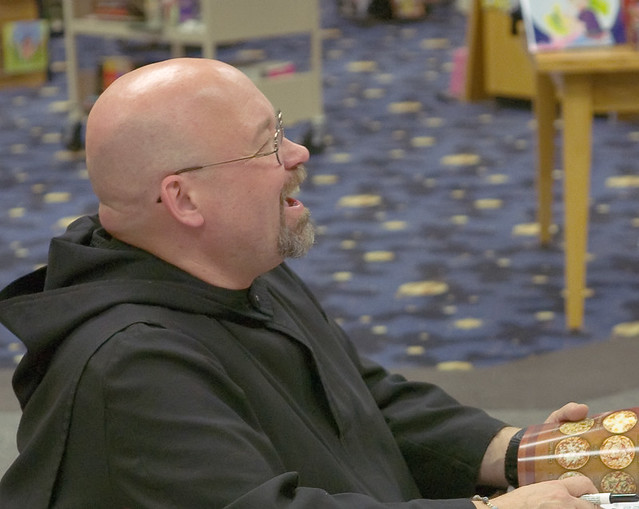
Here is Fr. Dominic, at the Borders Bookstore in Sunset Hills.
Click here for my earlier posting on this book.
I took the photo on the cover and of the pizzas.
Father Dominic is a Benedictine monk who lives at Saint Bede Abbey, in Peru, Illinois, and is known for his PBS television series Breaking Bread with Father Dominic.

Here is Fr. Dominic, at the Borders Bookstore in Sunset Hills.
Click here for my earlier posting on this book.
Saturday, October 23, 2010
For the Feast of Saint Boethius
SOME POEMS, from the Consolation of Philosophy, by Saint Anicius Manlius Severinus Boethius (480—ca. 525), sometimes called “the last of the Romans”, but who also saved the best of antiquity for Christendom. The Consolation was written while he was in prison awaiting execution.
Nothing can subdue Virtue.
Whoso calm, serene, sedate,Sets his foot on haughty fate;Firm and steadfast, come what will,Keeps his mien unconquered still;Him the rage of furious seas,Tossing high wild menaces,Nor the flames from smoky forgesThat Vesuvius disgorges,Nor the bolt that from the skySmites the tower, can terrify.Why, then, shouldst thou feel affrightAt the tyrant's weakling might?Dread him not, nor fear no harm,And thou shall his rage disarm;But who to hope or fear gives way—Lost his bosom's rightful sway—He hath cast away his shield,Like a coward fled the field;He hath forged all unawareFetters his own neck must bear!
Boethius' Prayer.
'Builder of yon starry dome,Thou that whirlest, throned eternal,Heaven's swift globe, and, as they roam,Guid'st the stars by laws supernal:So in full-sphered splendour dightCynthia dims the lamps of night,But unto the orb fraternalCloser drawn, doth lose her light.
'Who at fall of eventide,Hesper, his cold radiance showeth,Lucifer his beams doth hide,Paling as the sun's light groweth,Brief, while winter's frost holds sway,By thy will the space of day;Swift, when summer's fervour gloweth,Speed the hours of night away.
'Thou dost rule the changing year:When rude Boreas oppresses,Fall the leaves; they reappear,Wooed by Zephyr's soft caresses.Fields that Sirius burns deep grownBy Arcturus' watch were sown:Each the reign of law confesses,Keeps the place that is his own.
'Sovereign Ruler, Lord of all!Can it be that Thou disdainestOnly man? 'Gainst him, poor thrall,Wanton Fortune plays her vainest.Guilt's deserved punishmentFalleth on the innocent;High uplifted, the profanestOn the just their malice vent.
'Virtue cowers in dark retreats,Crime's foul stain the righteous beareth,Perjury and false deceitsHurt not him the wrong who dareth;But whene'er the wicked trustIn ill strength to work their lust,Kings, whom nations' awe declarethMighty, grovel in the dust.
'Look, oh look upon this earth,Thou who on law's sure foundationFramedst all! Have we no worth,We poor men, of all creation?Sore we toss on fortune's tide;Master, bid the waves subside!And earth's ways with consummationOf Thy heaven's order guide!'
Fortune's Malice.
Mad Fortune sweeps along in wanton pride,Uncertain as Euripus' surging tide;Now tramples mighty kings beneath her feet;Now sets the conquered in the victor's seat.She heedeth not the wail of hapless woe,But mocks the griefs that from her mischief flow.Such is her sport; so proveth she her power;And great the marvel, when in one brief hourShe shows her darling lifted high in bliss,Then headlong plunged in misery's abyss.
True Nobility.
All men are of one kindred stock, though scattered far and wide;For one is Father of us all—one doth for all provide.He gave the sun his golden beams, the moon her silver horn;He set mankind upon the earth, as stars the heavens adorn.He shut a soul—a heaven-born soul—within the body's frame;The noble origin he gave each mortal wight may claim.Why boast ye, then, so loud of race and high ancestral line?If ye behold your being's source, and God's supreme design,None is degenerate, none base, unless by taint of sinAnd cherished vice he foully stain his heavenly origin.
The Bondage of Passion.
When high-enthroned the monarch sits, resplendent in the prideOf purple robes, while flashing steel guards him on every side;When baleful terrors on his brow with frowning menace lower,And Passion shakes his labouring breast—how dreadful seems his power!But if the vesture of his state from such a one thou tear,Thou'lt see what load of secret bonds this lord of earth doth wear.Lust's poison rankles; o'er his mind rage sweeps in tempest rude;Sorrow his spirit vexes sore, and empty hopes delude.Then thou'lt confess: one hapless wretch, whom many lords oppress,Does never what he would, but lives in thraldom's helplessness.
The Unreasonableness of Hatred.
Why all this furious strife? Oh, whyWith rash and willful hand provoke death's destined day?If death ye seek—lo! Death is nigh,Not of their master's will those coursers swift delay!
The wild beasts vent on man their rage,Yet 'gainst their brothers' lives men point the murderous steel;Unjust and cruel wars they wage,And haste with flying darts the death to meet or deal.
No right nor reason can they show;'Tis but because their lands and laws are not the same.Wouldst thou give each his due; then knowThy love the good must have, the bad thy pity claim.
The True Sun.
Homer with mellifluous tonguePhœbus' glorious light hath sung,Hymning high his praise;Yet his feeble raysOcean's hollows may not brighten,Nor earth's central gloom enlighten.
But the might of Him, who skilledThis great universe to build,Is not thus confined;Not earth's solid rind,Nor night's blackest canopy,Baffle His all-seeing eye.
All that is, hath been, shall be,In one glance's compass, HeLimitless descries;And, save His, no eyesAll the world survey—no, none!Him, then, truly name the Sun.
A Psychological Fallacy.
From the Porch's murky depthsComes a doctrine sage,That doth liken living mindTo a written page;Since all knowledge comes throughSense,Graven by Experience.
'As,' say they, 'the pen its marksCuriously doth traceOn the smooth unsullied whiteOf the paper's face,So do outer things impressImages on consciousness.'
But if verily the mindThus all passive lies;If no living power withinIts own force supplies;If it but reflect again,Like a glass, things false and vain—
Whence the wondrous facultyThat perceives and knows,That in one fair ordered schemeDoth the world dispose;Grasps each whole that Sense presents,Or breaks into elements?
So divides and recombines,And in changeful wiseNow to low descends, and nowTo the height doth rise;Last in inward swift reviewStrictly sifts the false and true?
Of these ample potenciesFitter cause, I ween,Were Mind's self than marks impressedBy the outer scene.Yet the body through the senseStirs the soul's intelligence.
When light flashes on the eye,Or sound strikes the ear,Mind aroused to due responseMakes the message clear;And the dumb external signsWith the hidden forms combines.
The Upward Look.
In what divers shapes and fashions do the creatures great and smallOver wide earth's teeming surface skim, or scud, or walk, or crawl!Some with elongated body sweep the ground, and, as they move,Trail perforce with writhing belly in the dust a sinuous groove;Some, on light wing upward soaring, swiftly do the winds divide,And through heaven's ample spaces in free motion smoothly glide;These earth's solid surface pressing, with firm paces onward rove,Ranging through the verdant meadows, crouching in the woodland grove.Great and wondrous is their variance! Yet in all the head low-bentDulls the soul and blunts the senses, though their forms be different.Man alone, erect, aspiring, lifts his forehead to the skies,And in upright posture steadfast seems earth's baseness to despise.If with earth not all besotted, to this parable give ear,Thou whose gaze is fixed on heaven, who thy face on high dost rear:Lift thy soul, too, heavenward; haply lest it stain its heavenly worth,And thine eyes alone look upward, while thy mind cleaves to the earth!
Wednesday, October 20, 2010
Universal Health Care - An Alternative
THE RECENT health care reform proposals and legislation can certainly be called disastrous, and are a big issue in the upcoming elections. These reforms were done mainly within the Keynesian framework — a compromise between national government, trade unions, and large corporations — in a way which transparently benefits them most of all. These reforms, unchecked, will lead to further abortions, euthanasia, as well as the use of healthcare as a blunt weapon or political tool for further centralization and control in the future. Some people think this is a good thing, but I call that evil.
Since I dislike the tactic of people who complain without offering concrete counter-proposals, I will present one here. Here is a very rough outline of an alternative:
Libertarians or socialists will not like this system, but I think this is closer to a Catholic view of the matter. If you don't like the system, you know who to complain to — your own personal physician and local politician. Decisions are made by these individuals and not by some far-off bureaucrat, and so in this way it is far more democratic and more free than the alternatives.
Also, this ought to be low-cost. Large medical corporations often spend half their income on mergers and acquisitions, and of course government tends to be greedy for tax revenue, as well as lackluster in providing services. I think that this is not a compromise between current philosophies, but rather is a true alternative, one which trusts individuals within a framework of checks and balances. It is also more practical and loving.
Since I dislike the tactic of people who complain without offering concrete counter-proposals, I will present one here. Here is a very rough outline of an alternative:
- All physicians are owner-operators of their own business. They are not employees of any sort, of either a corporation or of a government agency. They are not contractors, but rather control their own practice. They set their own hours, conditions of work, and list of patients.
- All physicians have the right and the duty to join a local medical association. The local associations are free from external interference, and make up their own rules governing their members. Each physician-member has an equal vote in the association.
- These associations contract with the local government regarding community health care, with government and the associations being on equal footing in the negotiations. This contract covers all matters that are not those between patient and physician, such as immunization programs, disaster assistance, and health care of the indigent.
- Government has a duty to recognize the association and accept its members, and also has the right to set certain expectations for all the associations for the common good.
- The level of government ought to be as low as possible, for example, city government for the big cities, or counties in most other places. Contracts made at a lower level override contracts made at a higher level — the opposite of what we find typically.
- High-level associations — such as state-wide or national — will have the right to authoritatively propose policies, but local associations will have the right to implement these policies as they see fit, if at all.
- Every person living in a given area has the right to health care in that area, whether or not they are citizens, even if they have low quality of life or so-called Lebensunwertes Leben.
- Health care is provided according to a sliding scale of price. The rich pay more than the poor. This may be implemented in whatever way the local association and local government deems acceptable. Certainly this is best implemented by way of externals unrelated to health care, such as posh waiting rooms for the wealthy. First class accommodations serve the purpose of subsidizing the poorest ones.
- Every patient pays what they can, even if they can only pay a few dollars for a service, or even barter.
- You have to pay your dues. A physician cannot just open a cosmetic plastic surgery practice, but rather must first work his way to the top doing menial, unwanted jobs. This is an essential part of the system, and desirable practices are rewards for doing the unpleasant jobs first. For example, a young physician may have the duty to care for the indigent at low pay; but doing this for a certain number of years, he will have the right to a cushy practice — but not without first having paid his dues.
- Some cities may be quite wealthy, and others poor. Agreements between local associations will allow new physicians to 'pay their dues' in the poor areas before getting the comfortable practice in the wealthy area.
- Hospitals are independently operated as non-profit charities, in coordination with local governments and local physician associations. Local hospitals cooperate with each other to avoid expensive overlapping services, and cooperate with the government to provide adequate emergency services in case of natural disaster or epidemics.
- Insurance is handled locally by the physician associations, and ought to have very low overhead. Insurance for travelers ought to be organized via contracts between associations.
- Any complaints against a particular physician ought of course be first taken to the physician by the patient himself, and if satisfaction is not found, to the local medical association. Associations ought to have great flexibility in reassigning or punishing a member: even though a physician may be a poor surgeon, perhaps he might make an excellent pathologist. Only after running through the local association can the matter be taken to then courts, and even then local courts are best at serving local conditions. Punitive lawsuits tend to only make lawyers wealthy, as well as impose greater costs on everyone else. However, this ought not to mean that government cannot impose punishment on wrong-doing: rather, more gentle and inexpensive local solutions are often best.
- Nurses and other medical professionals ought to be organized along similar lines.
- Each profession is kept distinct, with their own customs, and areas of interest. Each profession ought to have a unique mode of dress appropriate to, as well as unambiguously identifying their profession. Dress also ought to be indicative of rank.
- All this is done for the good health of individual patients, while providing a decent living for medical workers.
Libertarians or socialists will not like this system, but I think this is closer to a Catholic view of the matter. If you don't like the system, you know who to complain to — your own personal physician and local politician. Decisions are made by these individuals and not by some far-off bureaucrat, and so in this way it is far more democratic and more free than the alternatives.
Also, this ought to be low-cost. Large medical corporations often spend half their income on mergers and acquisitions, and of course government tends to be greedy for tax revenue, as well as lackluster in providing services. I think that this is not a compromise between current philosophies, but rather is a true alternative, one which trusts individuals within a framework of checks and balances. It is also more practical and loving.
New Saints and Cardinals
BENEDICT XVI CANONISES SIX BLESSEDS
ANNUNCIO DI CONCISTORO PER LA CREAZIONE DI NUOVI CARDINALI , 20.10.2010
Included in the list of Cardinals-designate is Raymond Burke, Archbishop-emeritus of Saint Louis.
ANNUNCIO DI CONCISTORO PER LA CREAZIONE DI NUOVI CARDINALI , 20.10.2010
Included in the list of Cardinals-designate is Raymond Burke, Archbishop-emeritus of Saint Louis.
Monday, October 18, 2010
Sunday, October 17, 2010
Photos of Saint Patrick Church, in Grafton, Illinois
HERE ARE PHOTOS of Saint Patrick Church, in Grafton, Illinois. Located just two blocks from where the Illinois River drains into the Mississippi, this church is 37 miles — via automobile and ferry boat — northwest of downtown Saint Louis.
The church is a part of the Diocese of Springfield in Illinois.
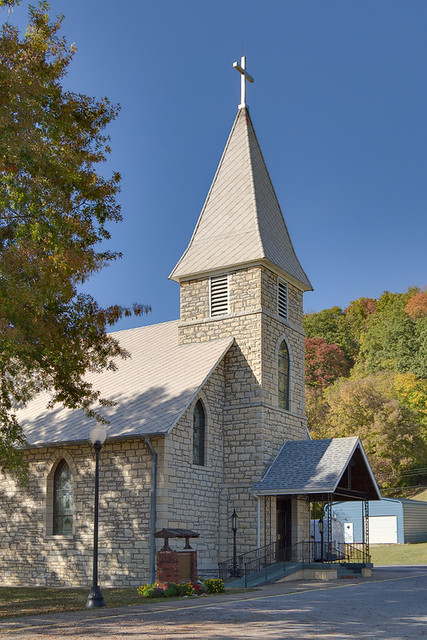
According to a plaque placed next to the church:
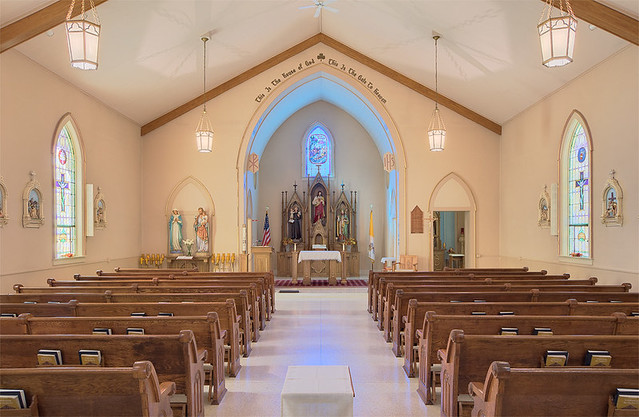
This small church is nicely decorated. During the flood, the water level was approximately at the Stations of the Cross.
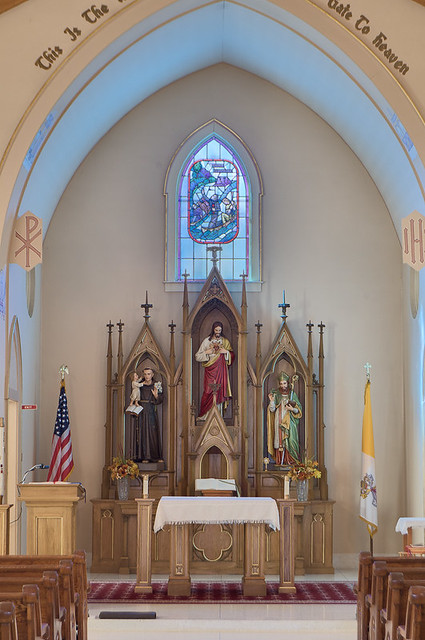
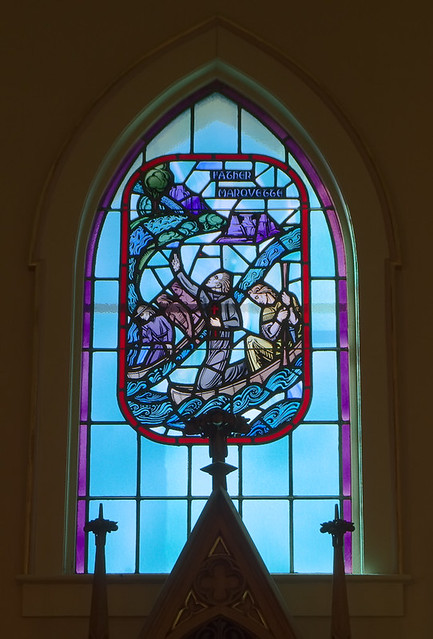
Above the altar is a window showing the exploration of this area by Louis Jolliet and Father Jacques Marquette, S.J. in 1673. The missionary work of Father Marquette has captured the imagination of Catholic in this region, and many churches in Illinois commemorates him: oddly, artistic depictions of Marquette are rare in Missouri.
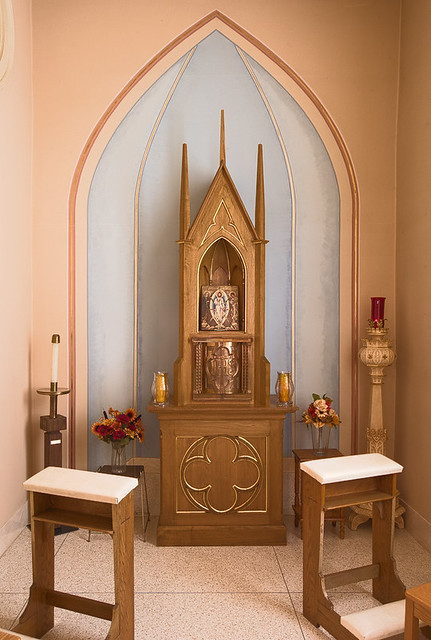
Adoration of the Blessed Sacrament is in a small chapel to the right of the sanctuary.
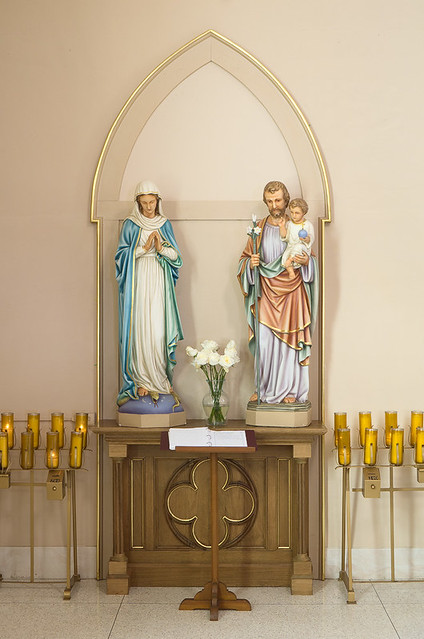
The Holy Family.
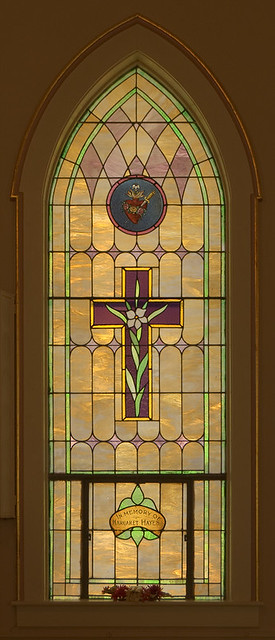
A stained glass window, showing the Immaculate Heart of Mary.
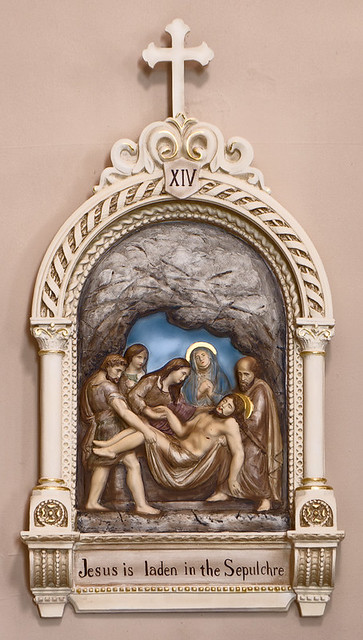
XIVth Station of the Cross, Jesus is laden in the Sepulchre.

In the choir loft above the organ console, a stained glass window of Saint Cecilia.
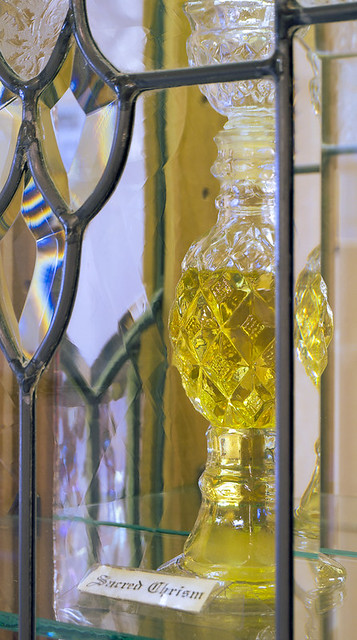
Sacred Chrism, located in the ambry near the door into the church.

Patriotic window above the front door shows the American flag and Cross.
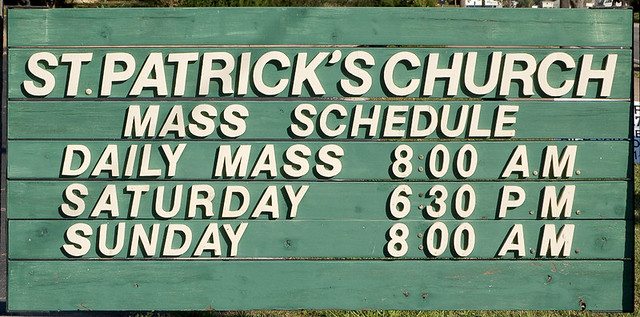
Sign with Mass times.
Address:
11 North Evans Street
Grafton, Illinois 62037
The church is a part of the Diocese of Springfield in Illinois.

According to a plaque placed next to the church:
For many years the Catholics in this vicinity had no church to worship in. Missionary priests came irregularly. Masses were held in various buildings, homes, and the Methodist Church. During the Depressed times of Ireland's famine these Irish families emigrated to Grafton to seek employment in the five stone quarries. The quarries employed 2,000 men 1,000 of whom were Irish immigrants. Due to the increasing Catholic families in Grafton the Germans and Irish decided on erecting a church built of native stone. There was a dispute on where the church should be built. A compromise was made; the church was erected here because the majority of Germans resided in upper Grafton, and the church was named as such in honor of the many Irish families. The first Mass was celebrated on Dec. 8, 1871 which was the feast of the Immaculate Conception. After restoration of the interior, damaged by the 1993 flood, it was rededicated by Bishop Daniel Ryan on March 19, 1995.

This small church is nicely decorated. During the flood, the water level was approximately at the Stations of the Cross.


Above the altar is a window showing the exploration of this area by Louis Jolliet and Father Jacques Marquette, S.J. in 1673. The missionary work of Father Marquette has captured the imagination of Catholic in this region, and many churches in Illinois commemorates him: oddly, artistic depictions of Marquette are rare in Missouri.

Adoration of the Blessed Sacrament is in a small chapel to the right of the sanctuary.

The Holy Family.

A stained glass window, showing the Immaculate Heart of Mary.

XIVth Station of the Cross, Jesus is laden in the Sepulchre.

In the choir loft above the organ console, a stained glass window of Saint Cecilia.

Sacred Chrism, located in the ambry near the door into the church.

Patriotic window above the front door shows the American flag and Cross.

Sign with Mass times.
Address:
11 North Evans Street
Grafton, Illinois 62037
Thursday, October 14, 2010
On the Upcoming Elections...
A GOOD MAN does not have the desire to rule over his fellow countrymen. Were power an intrinsically good thing, then we would not see so many evil men — or women — wielding it. Boethius tells us:
Traditionally, the solution is to thrust authority only upon those who do not seek or desire it. Nowadays, we want to get things done — even though we sharply disagree on what it is that ought to be done — and we will chose the shrewdest self-serving politicians for this end. Boethius instead encourages us to develop an interior, contemplative life, to increase our virtue and to be happy and blessed. We cannot have a good government unless the people involved are also good.
'Besides, if there were any element of natural and proper good in rank and power, they would never come to the utterly bad, since opposites are not wont to be associated. Nature brooks not the union of contraries. So, seeing there is no doubt that wicked wretches are oftentimes set in high places, it is also clear that things which suffer association with the worst of men cannot be good in their own nature. Indeed, this judgment may with some reason be passed concerning all the gifts of fortune which fall so plentifully to all the most wicked. This ought also to be considered here, I think: No one doubts a man to be brave in whom he has observed a brave spirit residing. It is plain that one who is endowed with speed is swift-footed. So also music makes men musical, the healing art physicians, rhetoric public speakers. For each of these has naturally its own proper working; there is no confusion with the effects of contrary things—nay, even of itself it rejects what is incompatible. And yet wealth cannot extinguish insatiable greed, nor has power ever made him master of himself whom vicious lusts kept bound in indissoluble fetters; dignity conferred on the wicked not only fails to make them worthy, but contrarily reveals and displays their unworthiness. Why does it so happen? Because ye take pleasure in calling by false names things whose nature is quite incongruous thereto—by names which are easily proved false by the very effects of the things themselves; even so it is; these riches, that power, this dignity, are none of them rightly so called. Finally, we may draw the same conclusion concerning the whole sphere of Fortune, within which there is plainly nothing to be truly desired, nothing of intrinsic excellence; for she neither always joins herself to the good, nor does she make good men of those to whom she is united.'— Boethius, The Consolation of Philosophy
Traditionally, the solution is to thrust authority only upon those who do not seek or desire it. Nowadays, we want to get things done — even though we sharply disagree on what it is that ought to be done — and we will chose the shrewdest self-serving politicians for this end. Boethius instead encourages us to develop an interior, contemplative life, to increase our virtue and to be happy and blessed. We cannot have a good government unless the people involved are also good.
Wednesday, October 13, 2010
Tuesday, October 12, 2010
Mantilla Giveaway.
KELLY of the Careless Catholic is giving away a free crocheted mantilla. Click here and leave a comment to enter.
Seeing a woman in a mantilla makes my heart go thump!
Seeing a woman in a mantilla makes my heart go thump!
Monday, October 11, 2010
Photos of Newly-ordained Father David Kemna, FSSP, Celebrating Mass at Saint Francis of Assisi Church, in Portage des Sioux, Missouri.
ORDAINED ON October 2nd, Father David Kemna of the Priestly Fraternity of Saint Peter (FSSP), returned to his home parish of Saint Francis of Assisi, in Portage des Sioux, Missouri, and yesterday celebrated the Holy Mass according to the Missal of Blessed John XXIII.
The small church was filled. Knights of Columbus served as honor guards, and seminarians, religious and Archdiocesan priests were in attendance as well as many of the faithful. Both the External Solemnity of Saint Francis of Assisi, and the 20th Sunday after Pentecost were commemorated.
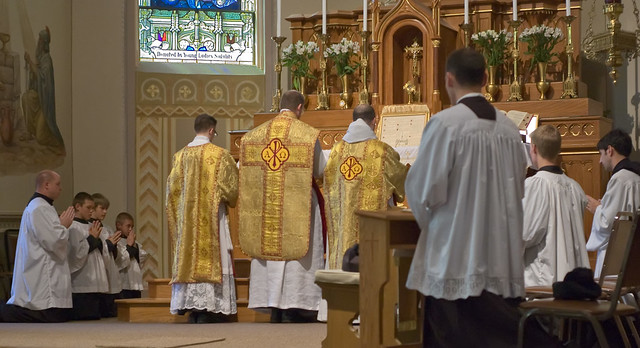
Prayers at the foot of the altar.
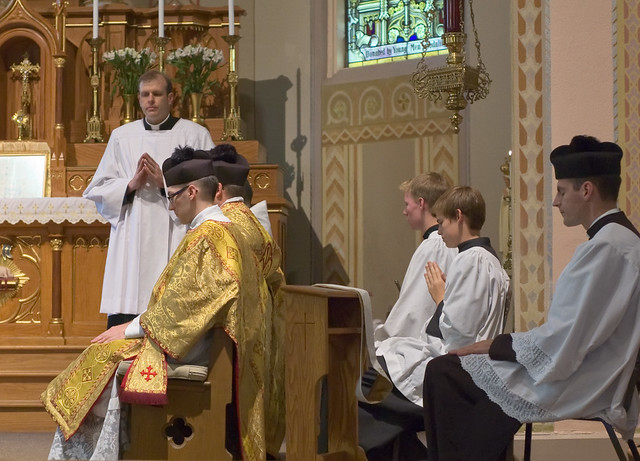
During the Kyrie.
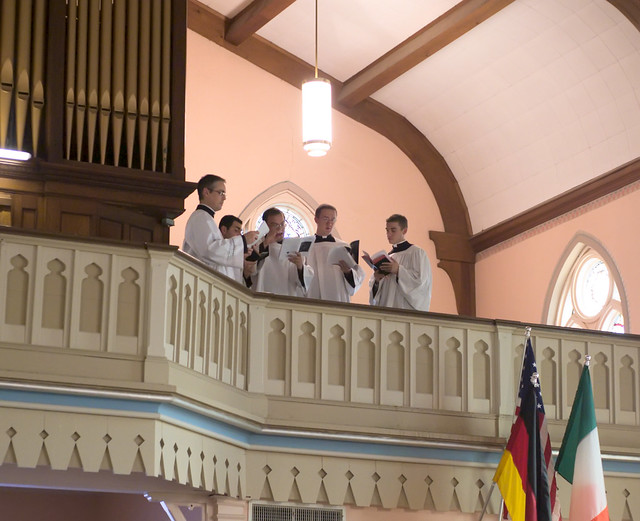
Members of the Gregorian Schola of Kenrick-Glennon Seminary, of the Archdiocese of Saint Louis.

Blessing before the Gospel.
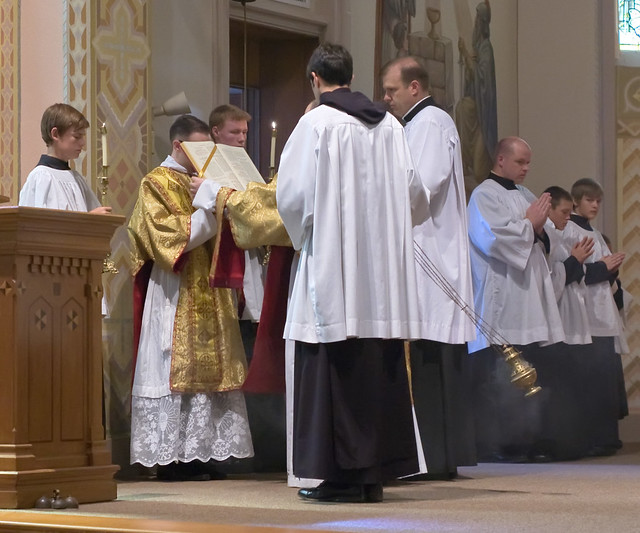
Reading the Gospel.
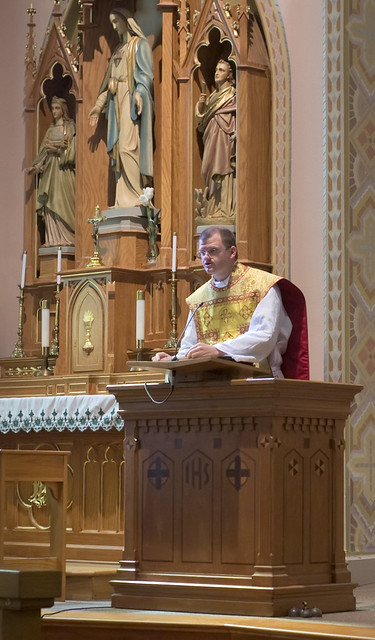
Fr. Kemna preparing to preach the homily.
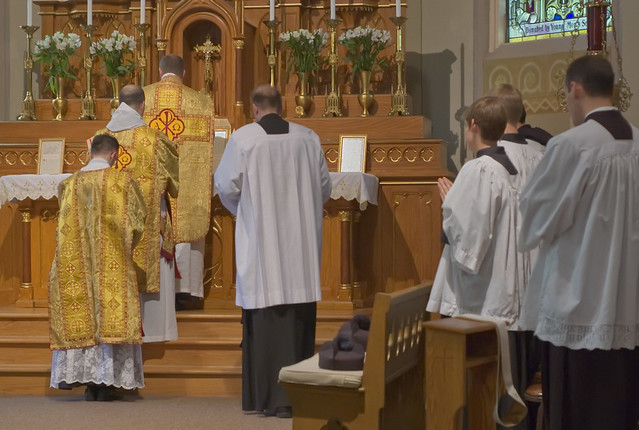
Prayers before the Canon of the Mass.
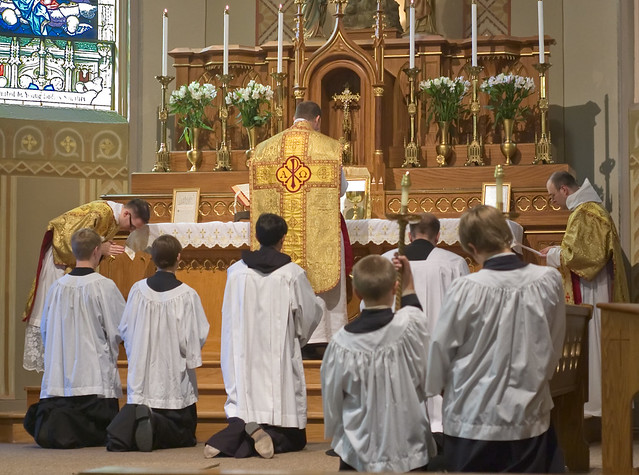
Prayers before the Consecration.

Knights of Columbus during the final prayers. Mass ended with the Te Deum.
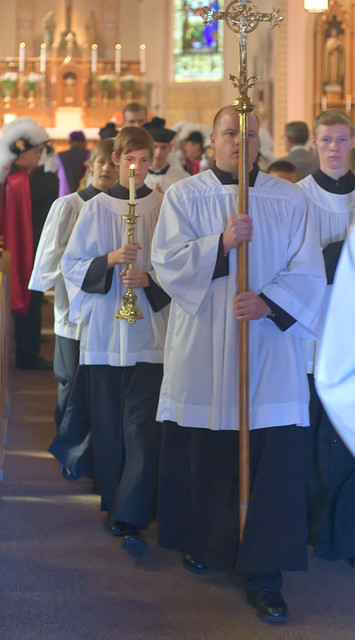
Procession out of the church.
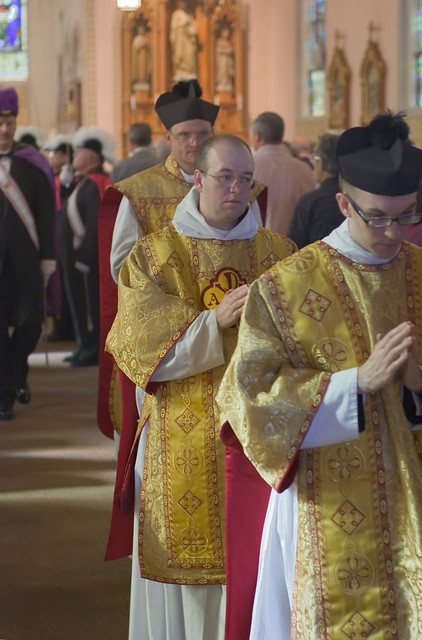
Clergy process out.
Photos of Father Kemna's ordination can be found here.
The small church was filled. Knights of Columbus served as honor guards, and seminarians, religious and Archdiocesan priests were in attendance as well as many of the faithful. Both the External Solemnity of Saint Francis of Assisi, and the 20th Sunday after Pentecost were commemorated.

Prayers at the foot of the altar.

During the Kyrie.

Members of the Gregorian Schola of Kenrick-Glennon Seminary, of the Archdiocese of Saint Louis.

Blessing before the Gospel.

Reading the Gospel.

Fr. Kemna preparing to preach the homily.

Prayers before the Canon of the Mass.

Prayers before the Consecration.

Knights of Columbus during the final prayers. Mass ended with the Te Deum.

Procession out of the church.

Clergy process out.
Photos of Father Kemna's ordination can be found here.
Photos at Marais Temps Clair
FOR YOUR ENJOYMENT, here are some photos I took yesterday, at Marais Temps Clair Conservation Area, near Portage des Sioux, in a rural section of Saint Charles County, Missouri.
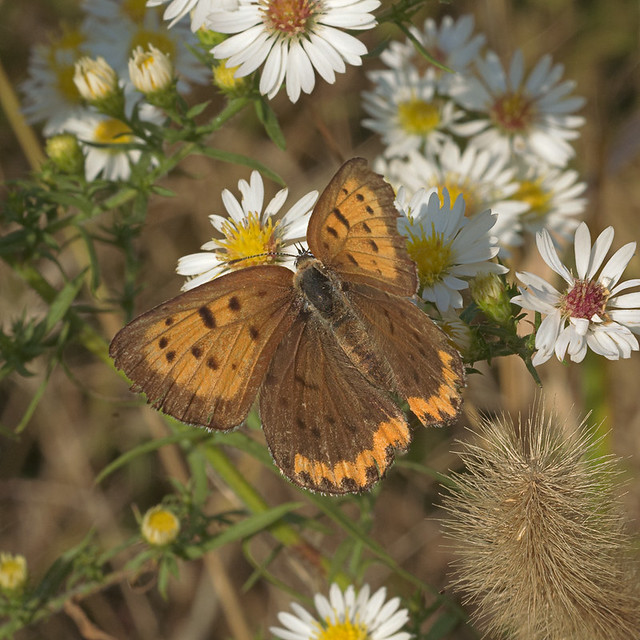
Located on a great floodplain between the Missouri and Mississippi Rivers, Marais Temps Clair (French for ‘Fair Weather Marsh’) is an oxbow lake, remnants of a former channel of the Missouri River. These days, the land is mainly managed for waterfowl habitat, but an abundance of frogs and a variety of flora can be found here too.
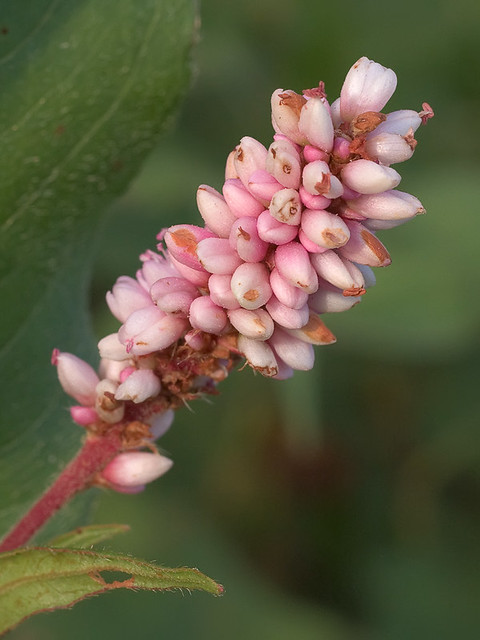
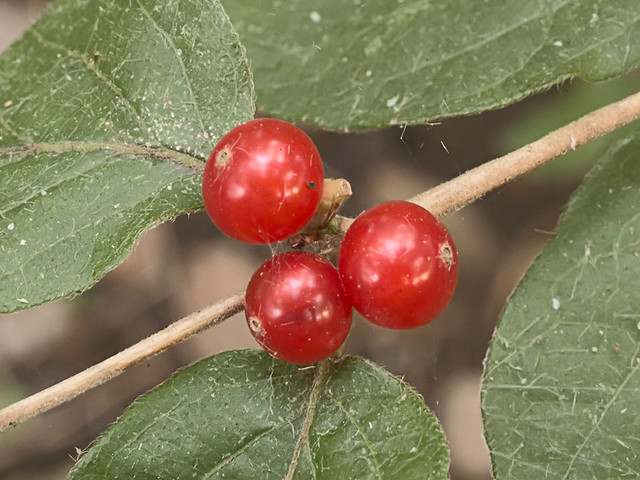
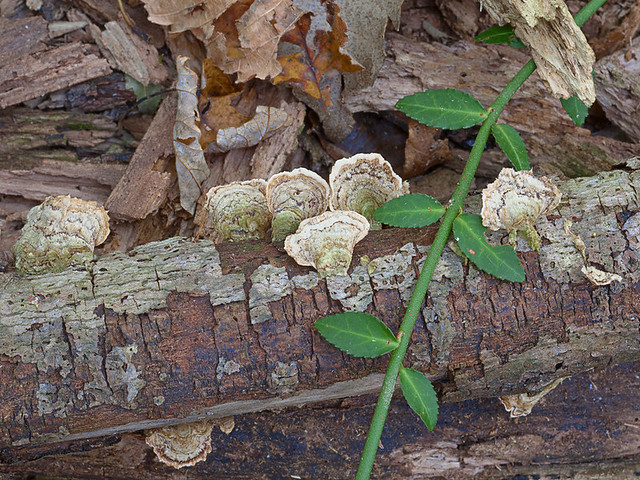
Just the other day, I posted numerous photos of mushrooms. Here are some more, and this time I was a bit more careful with my picture-taking. The area of this photo is adjacent to a swamp, and I was eaten alive by mosquitos. I found out that mushrooms do not grow on swampy ground — but this drier upland area had an abundance.
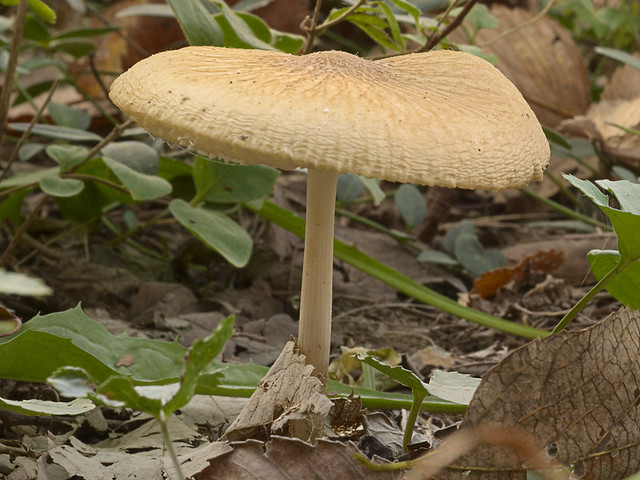
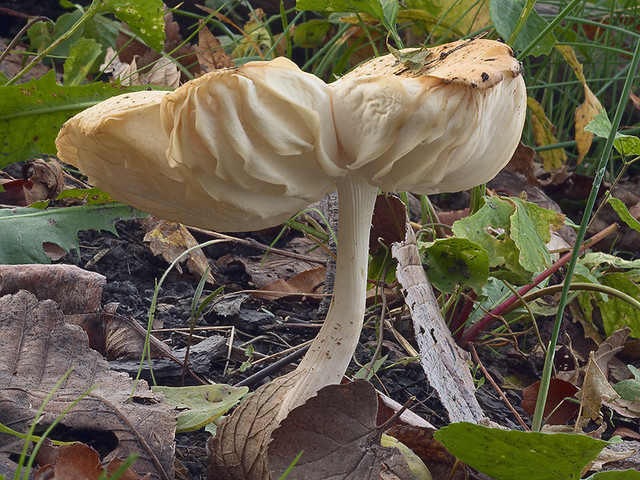
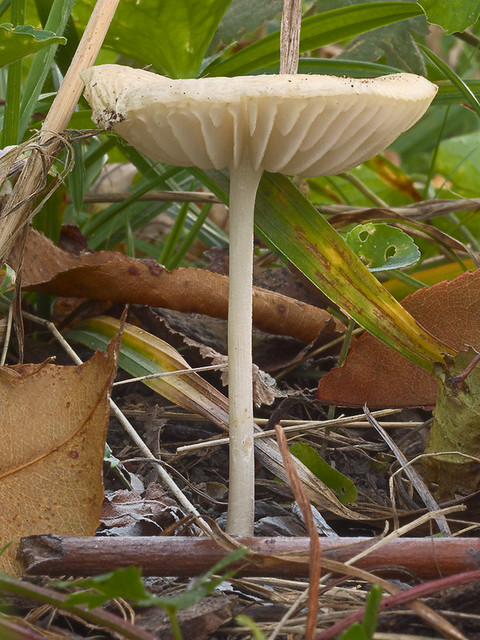

Located on a great floodplain between the Missouri and Mississippi Rivers, Marais Temps Clair (French for ‘Fair Weather Marsh’) is an oxbow lake, remnants of a former channel of the Missouri River. These days, the land is mainly managed for waterfowl habitat, but an abundance of frogs and a variety of flora can be found here too.



Just the other day, I posted numerous photos of mushrooms. Here are some more, and this time I was a bit more careful with my picture-taking. The area of this photo is adjacent to a swamp, and I was eaten alive by mosquitos. I found out that mushrooms do not grow on swampy ground — but this drier upland area had an abundance.



Saturday, October 09, 2010
A Myriad of Mushrooms
MUSHROOMS ARE fascinating organisms. The appear suddenly without notice, and in a wide variety of forms and colors. Biologists tell us that these and other fungi belong to a classificatory kingdom that also includes yeast. These organisms are so distinct that biologists do not place them with the plants: these even have biochemical processes that make them more similar to the animals. Unlike plants, mushrooms and other fungi do not use photosynthesis, but rather these feed off of decaying matter. The mushroom parts that we see are the fruit of the organism, while most of it — the mycelium — actually remains under the ground.
The undergroud mycelium can be enormous and ancient. Some have been found to be thousands of years old and thousands of acres in size. In my own yard, one variety or another pops up periodically all over my lawn.
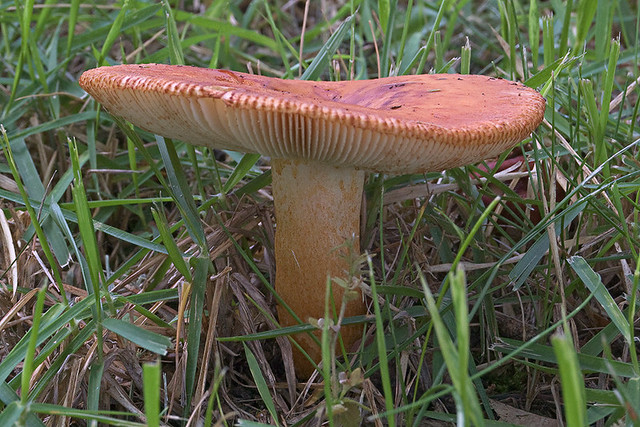
We lately have experienced a bumper crop of mushrooms — perhaps because of this year's greater-than-average rainfall. My career in mushroom photography started this spring: the mushroom above was on my front lawn, and as the summer and fall progressed, my camera was drawn to photographing each one that I found. Unfortunately, I never used my best technique when photographing these (not wanting to lug around extra equipment in the woods), so these are just casual snapshots.

Since I was a young child, I was fascinated with the stories my mother told me about her father, who was an expert at foraging for plants and mushrooms as well as other outdoor skills. I still remember being at my mother's knee, looking at drawings in a book, showing poisonous mushrooms that looked nearly identical to edible varieties. So I know nothing of mushrooms, other than to be extremely careful.
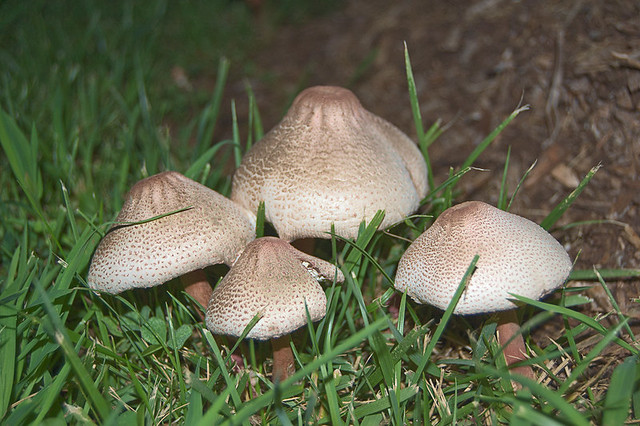
“The fear of the Lord is the beginning of wisdom,” wrote King Solomon, and fear of the natural world is likewise prudent, especially for young children who are wont to put everything into their mouth. A naïve understanding of the goodness of nature, like the goodness of God, is eminently dangerous. So perhaps it is prudent to inculcate first in children a fear of at least certain parts of nature and their inherent dangers: hereabouts the common dangers would include mushrooms, poison ivy, skunks, and snakes of the pit viper family.
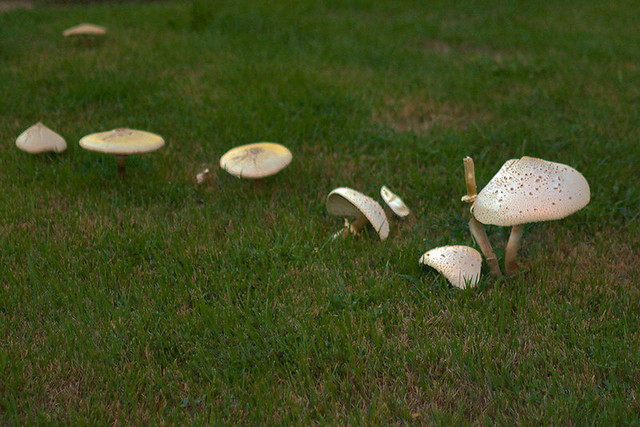
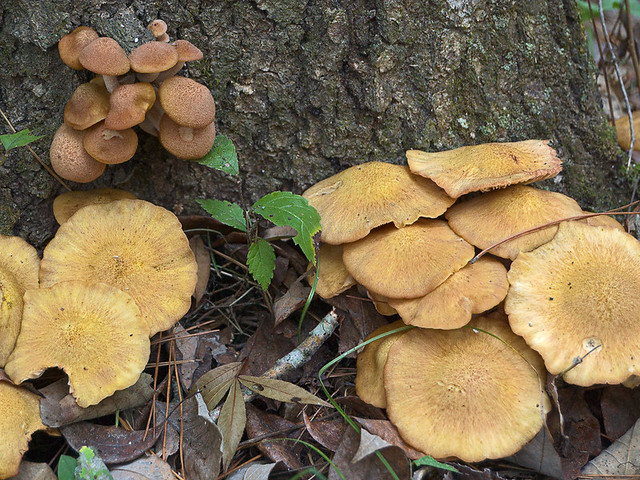
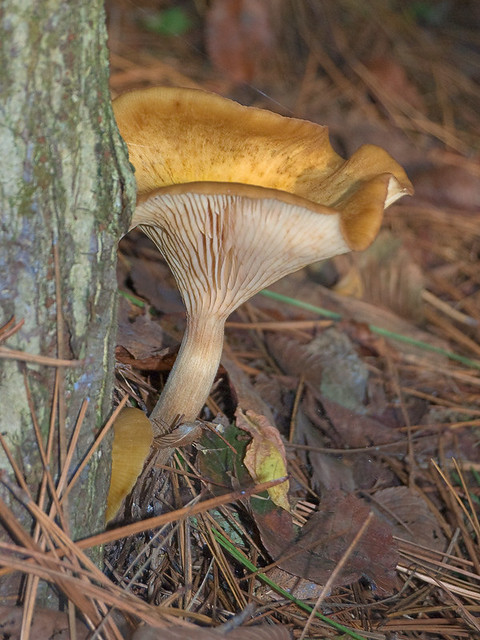
Many mushrooms can only be definitively identified at full, flourishing maturity; others require chemical tests, and there are many practical methods which only work in specific localities. While local guidebooks — I repeat, local guides designed for your specific area — are handy, I would not rely on them too much. It is always prudent to ask the advice of a local expert — however, don't expect these experts to tell you the locations of their favorite morel patches! Mushroom foraging is not the pursuit of the urban dilettante.
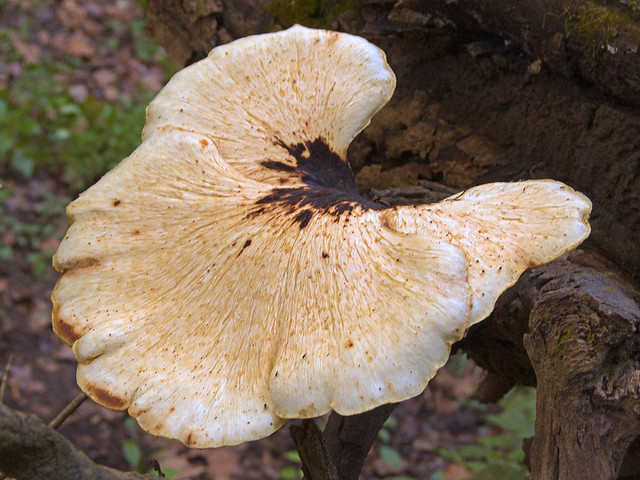
This is perhaps the largest mushroom I've ever seen. It was about a foot and a half across.
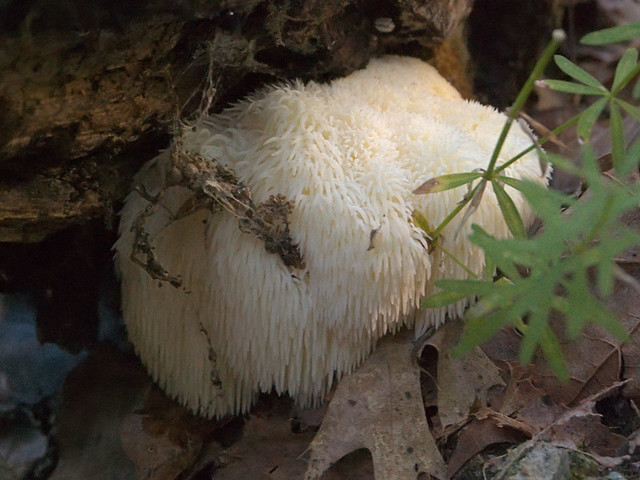
I was told this is a Lion's mane mushroom.

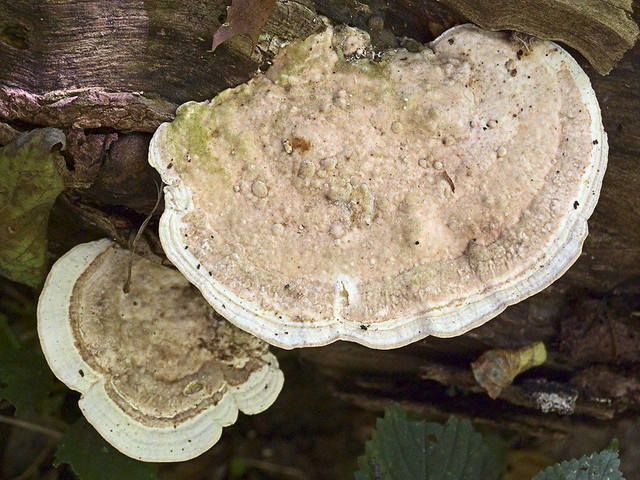
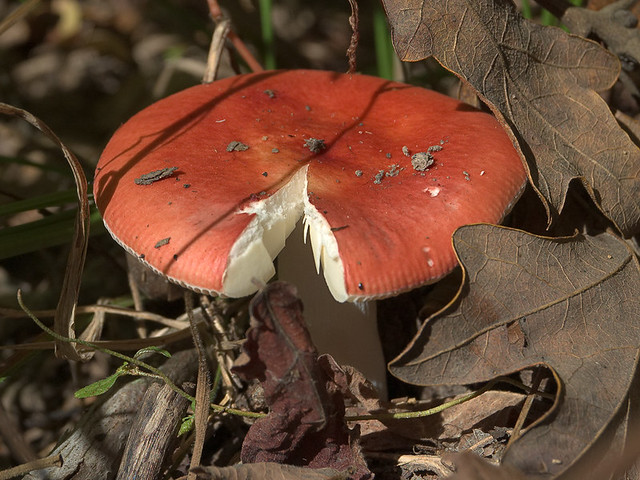
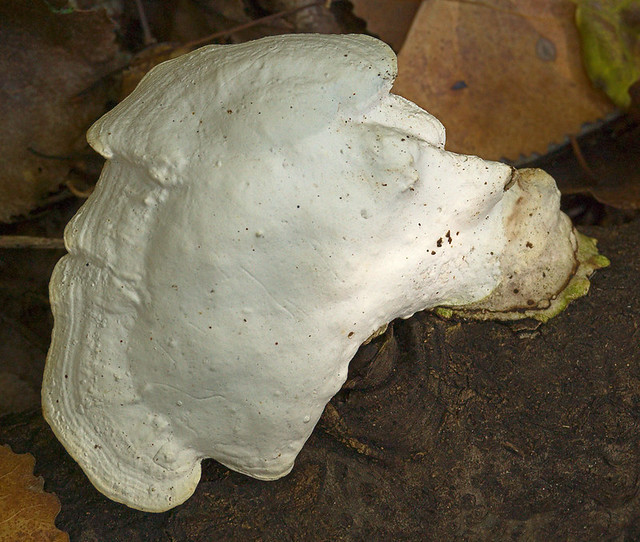
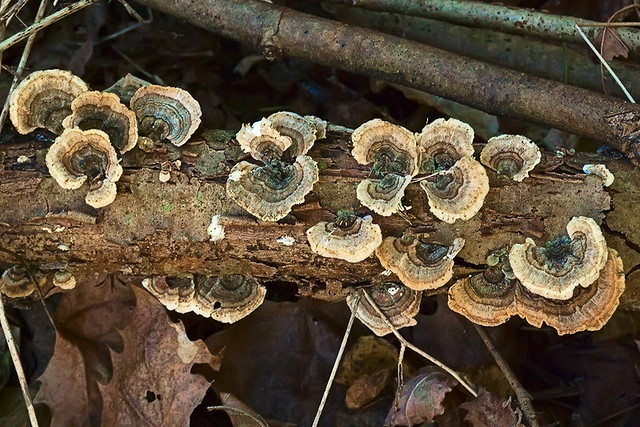
All these photos were hand-held, and suffer from lack of quality; the fact that it was dark makes it even harder to be sure that the photos both have enough of the subject in focus and not blurred due to camera shake. So in most cases, I boosted the camera's sensitivity to light, which causes digital noise; I used noise reduction software which removes some of the detail, particularly in the shadows.
If you think these photos are fine, please know that I have many more that are not fine and which I'm not showing you here.
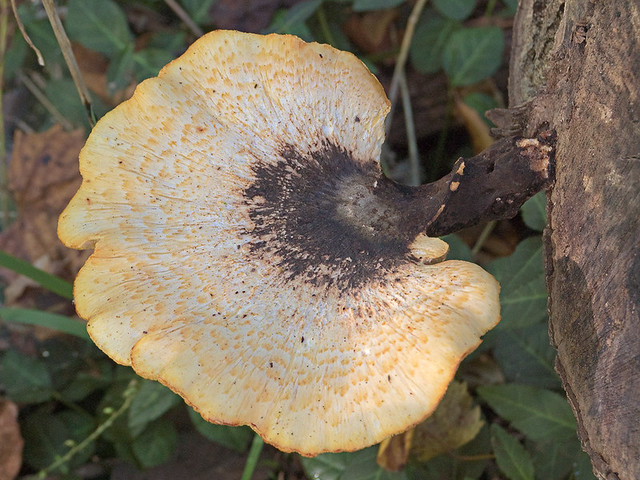
One of the basic tools of the photographer is a tripod; having a steady platform corrects many ills and makes even an inexpensive camera the tool of a fine artist. I think these photos would have been improved with the use of a tripod, for these reasons:
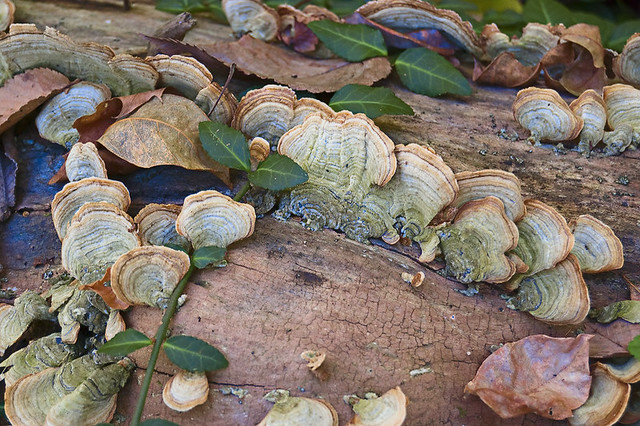
Another useful tool is a Macro (or Micro) lens. These lenses have been optimized specifically to be sharp at close focus. For my camera, there are some Micro lenses that have been made in such huge quantities over the decades that they are quite inexpensive.
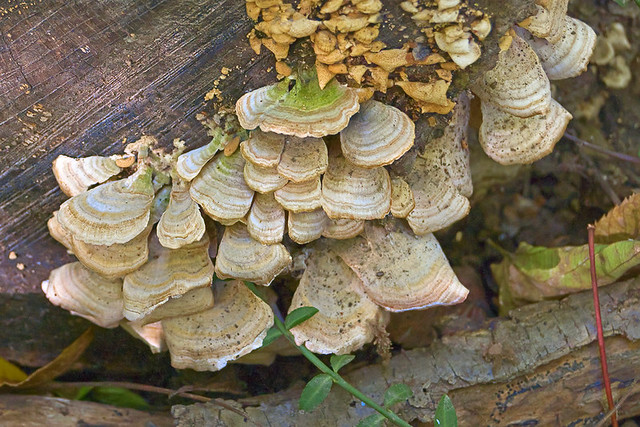
Any photographer who uses his camera's built in flash without good reason may be in a state of sin against art. Flashes are fine, as long as they are detached from the camera by quite a distance — otherwise they throw harsh shadows and generally give poor quality of lighting. Strangely, ring flashes that completely surround the lens also produce quality light, and these are often used in this kind of nature photography.
However, I did use my camera's built in flash on a number of these photos — I wouldn't be able to get a shot otherwise.
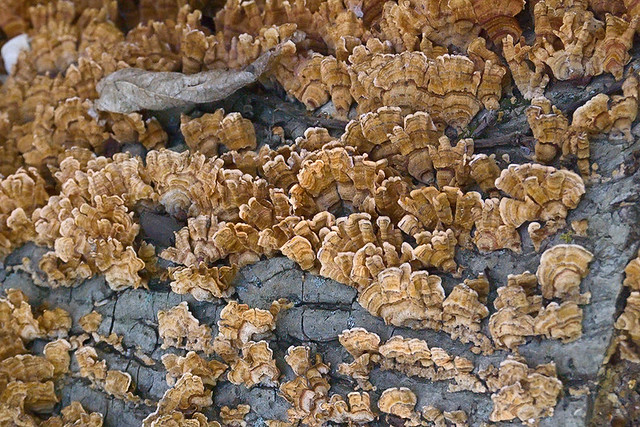
Photography in dim lighting pushes the camera to its practical limits, and so getting exposure right is rather more important. Also, getting the camera white balance correct becomes important because of the green lighting coming from the forest canopy; however I just guessed on most of these shots. On the camera's Auto setting, the colors were usually pretty bad. Where I more serious about this — like I am with church photography — I would have brought a white target for white balance calibration, ensuring that the camera saw the target as actually being white.
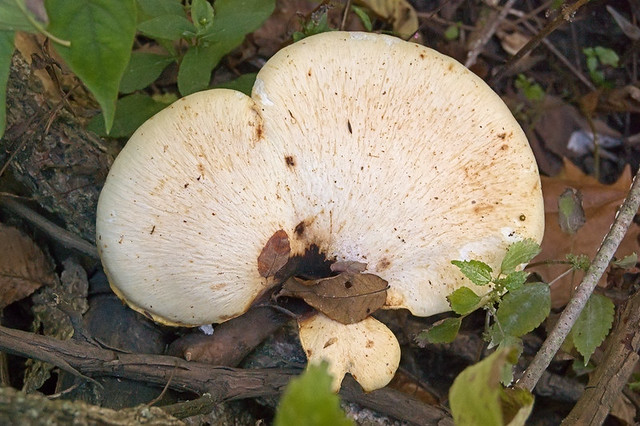
These photos were taken over several months and at various places. If you click the photos, you can both see a larger size as well as the area where I took the photo.

The most prolific mushroom area was also the closest and smallest. Bittersweet Woods and Phantom Forest are two almost-adjacent conservation areas located in the town of Des Peres, in Saint Louis County. Phantom Forest, by the way, comes from land donated by Ray Moore, co-creator of The Phantom comic strip.
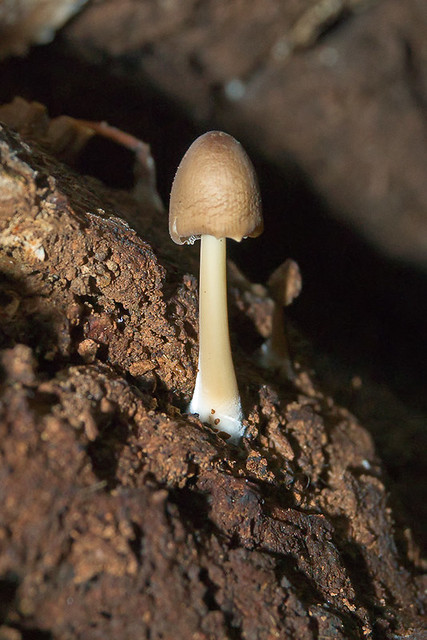
A tiny mushroom.
More recent mushroom photos can be found here.
The undergroud mycelium can be enormous and ancient. Some have been found to be thousands of years old and thousands of acres in size. In my own yard, one variety or another pops up periodically all over my lawn.

We lately have experienced a bumper crop of mushrooms — perhaps because of this year's greater-than-average rainfall. My career in mushroom photography started this spring: the mushroom above was on my front lawn, and as the summer and fall progressed, my camera was drawn to photographing each one that I found. Unfortunately, I never used my best technique when photographing these (not wanting to lug around extra equipment in the woods), so these are just casual snapshots.

Since I was a young child, I was fascinated with the stories my mother told me about her father, who was an expert at foraging for plants and mushrooms as well as other outdoor skills. I still remember being at my mother's knee, looking at drawings in a book, showing poisonous mushrooms that looked nearly identical to edible varieties. So I know nothing of mushrooms, other than to be extremely careful.

“The fear of the Lord is the beginning of wisdom,” wrote King Solomon, and fear of the natural world is likewise prudent, especially for young children who are wont to put everything into their mouth. A naïve understanding of the goodness of nature, like the goodness of God, is eminently dangerous. So perhaps it is prudent to inculcate first in children a fear of at least certain parts of nature and their inherent dangers: hereabouts the common dangers would include mushrooms, poison ivy, skunks, and snakes of the pit viper family.

These are very large mushrooms, found at dusk in my neighborhood.
We do not rely on scientists to tell us which mushrooms are edible; rather we rely on the long handing-down of tradition, and it would be foolish to eat any plant or fungi that has no tradition of edibility. You can only feel pity for the people who started the traditions, likely thousands of years ago, who first discovered the edible foods, or rather who found out painfully which plants were not edible. One thing is rather certain: we can trace many of our food traditions to very specific places, and so many of our cultivated plants are native only to particular locales.

But what if you are lost or stranded in the wilderness, and your hunger grows greater by the hour? My father tells me of the advice found in the survival training of the military and Boy Scouts. First, I would see if something looks and smells like food; does it delight the senses? Now this can be perilous, but try eating just a small amount of it; if it tastes good and you have no reaction, and feel fine, then try a bit more at one time. If you don't get sick, then it might be edible. If animals, particularly mammals are eating it, then it might be OK — or not, if they are ruminants like deer, horses, or cattle who can digest foods that humans cannot. Rather it is better finding out which wilds foods are most definitely edible, and perhaps this is a lesson best learned by an older child.

Many mushrooms can only be definitively identified at full, flourishing maturity; others require chemical tests, and there are many practical methods which only work in specific localities. While local guidebooks — I repeat, local guides designed for your specific area — are handy, I would not rely on them too much. It is always prudent to ask the advice of a local expert — however, don't expect these experts to tell you the locations of their favorite morel patches! Mushroom foraging is not the pursuit of the urban dilettante.

This is perhaps the largest mushroom I've ever seen. It was about a foot and a half across.

I was told this is a Lion's mane mushroom.

I have not been able to find any references to mushrooms in Sacred Scripture. Other fungi like blight and mildew are mentioned in the Holy Bible either as a plague on crops or a source of Old Testament ritual impurity. Yeast, also a fungus, has a number of references, it being a symbol of the Kingdom of Heaven, but it has a negative connotation also — see Matthew 16:11-12.

The Fathers and Doctors of the church mention mushrooms rarely. Anobius of Sicca thinks they are an excessively dainty food, while Saint Irenaeus compares heretics to mushrooms that spring up overnight. Likewise Saint Augustine thinks mushrooms are a dainty food — that is, a luxury food such as caviar is thought of today — and mentions their dangers. Saint Francis de Sales repeats the physicians' advice that mushrooms should be eaten sparingly, and notes that they often cause sickness.

In the Orient, mushrooms symbolize many things, including fertility, immortality, and good government; in the West, the mushroom lacks nearly all symbolism except that of rapid growth. Even then, this rapid growth is not usually positive, mainly because the fruit of the mushroom is so often poisonous, and also because this growth is fleeting and soon to pass. Rather, those who analogize about mushrooms state that we must instead be patient and prudent: a grape vine or olive tree takes many years and much effort to cultivate, but the fruit of these are worth the wait.

In nearly all these photographs, the mushrooms were found in deep shade of the dark forest, typically growing on fallen, rotted tree trunks.
I think I started taking these photos of mushrooms partly because they are larger than flowers — and so easier to get a good in-focus shot — and because they photograph so much better than general forest scenes. You might want to read an article I wrote on the disappointments of forest photography here. Also, because I think mushrooms are a curious and rare delight.
I think I started taking these photos of mushrooms partly because they are larger than flowers — and so easier to get a good in-focus shot — and because they photograph so much better than general forest scenes. You might want to read an article I wrote on the disappointments of forest photography here. Also, because I think mushrooms are a curious and rare delight.

All these photos were hand-held, and suffer from lack of quality; the fact that it was dark makes it even harder to be sure that the photos both have enough of the subject in focus and not blurred due to camera shake. So in most cases, I boosted the camera's sensitivity to light, which causes digital noise; I used noise reduction software which removes some of the detail, particularly in the shadows.
If you think these photos are fine, please know that I have many more that are not fine and which I'm not showing you here.

One of the basic tools of the photographer is a tripod; having a steady platform corrects many ills and makes even an inexpensive camera the tool of a fine artist. I think these photos would have been improved with the use of a tripod, for these reasons:
- A steady camera foundation lessens camera shake and allows for precise focus.
- Less light amplification means less digital noise and a cleaner image with more detail.
- Closing down the aperture on the lens means that more of the subject is in focus.

Another useful tool is a Macro (or Micro) lens. These lenses have been optimized specifically to be sharp at close focus. For my camera, there are some Micro lenses that have been made in such huge quantities over the decades that they are quite inexpensive.

Any photographer who uses his camera's built in flash without good reason may be in a state of sin against art. Flashes are fine, as long as they are detached from the camera by quite a distance — otherwise they throw harsh shadows and generally give poor quality of lighting. Strangely, ring flashes that completely surround the lens also produce quality light, and these are often used in this kind of nature photography.
However, I did use my camera's built in flash on a number of these photos — I wouldn't be able to get a shot otherwise.

Photography in dim lighting pushes the camera to its practical limits, and so getting exposure right is rather more important. Also, getting the camera white balance correct becomes important because of the green lighting coming from the forest canopy; however I just guessed on most of these shots. On the camera's Auto setting, the colors were usually pretty bad. Where I more serious about this — like I am with church photography — I would have brought a white target for white balance calibration, ensuring that the camera saw the target as actually being white.

These photos were taken over several months and at various places. If you click the photos, you can both see a larger size as well as the area where I took the photo.

The most prolific mushroom area was also the closest and smallest. Bittersweet Woods and Phantom Forest are two almost-adjacent conservation areas located in the town of Des Peres, in Saint Louis County. Phantom Forest, by the way, comes from land donated by Ray Moore, co-creator of The Phantom comic strip.

A tiny mushroom.
More recent mushroom photos can be found here.
Subscribe to:
Posts (Atom)


